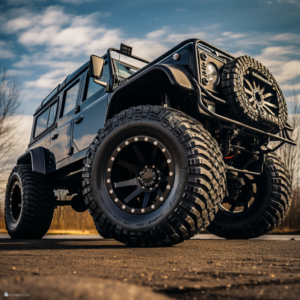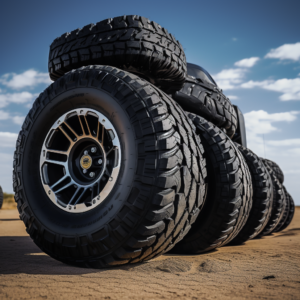30-inch tires for your can- am defender-
Intro:
As an off-road enthusiast, you understand the importance of having the right tires on your vehicle. And if you own a Defender, you know that having the right tires can make all the difference in your off-road adventures. But with so many options available, it can be challenging to determine which size tires are best for your Defender. One size that many enthusiasts consider is 30-inch tires. However, before you make the switch, there are several factors to consider. In this comprehensive guide, we will explore the pros and cons of 30-inch tires and help you determine if they are the right choice for your Defender. From the benefits they offer to the potential downsides, we will cover everything you need to know to make an informed decision. So, buckle up and let’s dive into the world of 30-inch tires for your Defender.
30-inch tires can offer several benefits for an All-Terrain Vehicle like a Can-Am Defender, but there are also some drawbacks to consider.

Here are some pros and cons of 30-inch tires for a Can-Am Defender:
Pros:
Increased ground clearance:
With larger tires, the Defender’s undercarriage will be lifted higher off the ground. This will allow for better clearance over obstacles like rocks, logs, and ruts.
Improved traction:
The larger tire diameter and wider tread pattern can provide better traction on loose or slippery surfaces like mud, sand, and snow.
Enhanced stability:
Wider tires create a larger contact patch with the ground. This can improve the vehicle’s stability and handling, particularly when cornering.
Better appearance:
30-inch tires can give your Defender a more aggressive and stylish look.
Cons:
Increased weight:
Larger tires are generally heavier than smaller ones. This can put extra strain on the vehicle’s suspension and drivetrain. This extra weight can also affect the vehicle’s acceleration and top speed.
Reduced fuel efficiency:
The added weight and increased rolling resistance of larger tires can cause a reduction in fuel economy.
Higher cost:
Larger tires are typically more expensive than smaller ones. Upgrading to 30-inch tires can be a significant investment for your defender.
More difficult steering:
Larger tires require more effort to turn, so the steering may feel heavier and less responsive than with smaller tires.
Overall, 30-inch tires can provide several benefits for a Can-Am Defender, but they also have some drawbacks. It is important to weigh the pros and cons carefully before deciding to upgrade your tires.

There are factors to consider before installing 30-inch tires on your Can-Am Defender-
Here are some important factors to keep in mind:
Compatibility:
Make sure you choose the right 30-inch tires for your Can-Am Defender. Check your vehicle’s owner manual or consult with a professional mechanic. Do this to ensure that the chosen tires meet the recommended specifications for your specific vehicle model.
Purpose:
Consider the primary purpose of your vehicle. If you use your Can-Am Defender for heavy-duty work like hauling and towing, or frequently travel on rough terrains, then upgrading to 30-inch tires may be beneficial. However, if you use your vehicle mostly for light recreational activities or driving on smooth terrains, larger tires may not be necessary.
Clearance:
Ensure that the 30-inch tires you choose provide enough clearance for your vehicle. Consider the height of your vehicle, tire you plan to install and any suspension modifications you may have made.
Wheel size:
Make sure that the wheel size of the 30-inch tire is compatible with your defender’s rims. Larger tires may require larger wheels to accommodate them, so you may need to invest in new wheels as well.
Cost:
Upgrading to 30-inch tires can be expensive, so it’s important to consider the cost of both the tires and any additional parts or modifications that may be required to install them. Be sure to factor in the cost of labour if you plan to have the tires installed professionally.
Performance:
Consider how the 30-inch tires will affect your vehicle’s performance. Larger tires may provide better traction and stability on rough terrain. But they may also impact your vehicle’s acceleration, top speed, and fuel economy.
Legal requirements:
Ensure that the 30-inch tires you choose comply with the maximum tire size or lift restrictions. Check with your local DMV or law enforcement agency to ensure that the tires you choose are legal for use on public roads.

Measuring for 30-inch tires is a straightforward process. But it is important to take accurate measurements. This is to ensure that the tires you choose are the right size for your Can-Am Defender.
Here is how to measure for 30-inch tires:
Determine the rim size:
Check the size of your existing rims to determine the correct size for your new tires. The rim size should be printed on the side of the tire. You can measure the diameter of the rim from bead seat to bead seat using a tape measure.
Measure the tire height:
Measure the distance from the ground to the highest point of the tire’s tread, or the top of the tire’s sidewall. This measurement is often referred to as the tire’s overall diameter. For accurate results, measure the tire while it is mounted on the vehicle.
Calculate the size difference:
To determine the difference in size, subtract the overall diameter of your current tire from the overall diameter of the new tire. Divide the result by 2 to get the difference in tire height. For example, if your current tires have an overall diameter of 26 inches, the difference in tire height between your current tires and 30-inch tires would be 2 inches.
Check clearance:
Check your Can-Am Defender for clearance to ensure that the new tires will fit without rubbing or causing damage. Measure the distance between the top of your existing tires and the nearest point of the vehicle’s fender, suspension, or other components. Compare this measurement to the difference in tire height calculated in step 3. If the difference in tire height is greater than the clearance distance, you may need to adjust your vehicle’s suspension or install a lift kit to accommodate the larger tires.
By following these steps, you can determine the correct size of 30-inch tires for your Can-Am Defender and ensure that they fit properly without causing clearance issues or other problems.

Here are some popular options for choosing the best 30-inch tire for your Can-Am Defender:
Maxxis Bighorn 2.0:
The Maxxis Bighorn 2.0 is a popular choice for off-road enthusiasts, offering excellent traction and durability in a variety of terrains. The tire features a non-directional tread pattern that provides a smooth ride and reliable grip on rocky, muddy, and sandy surfaces.
ITP Blackwater Evolution:
The ITP Blackwater Evolution is another top-performing tire for Can-Am Defenders. This tire features a unique non-directional tread design that provides superior traction and handling in various conditions. The tire is also durable and long-lasting, making it a great investment for frequent off-road use.
Sedona Coyote:
The Sedona Coyote is a versatile tire that offers reliable performance both on and off the road. The tire features a durable 8-ply construction and a deep, aggressive tread pattern that provides excellent traction and stability in challenging terrain. The Coyote also offers a smooth, comfortable ride on paved surfaces.
GBC Dirt Commander:
The GBC Dirt Commander is a popular all-terrain tire that delivers superior traction, handling, and durability. The tire features a rugged, deep tread pattern that provides excellent grip in mud, sand, and rocky terrain. The Dirt Commander is also known for its long-lasting performance, making it a reliable choice for off-road enthusiasts.
STI Chicane RX:
The STI Chicane RX is a versatile tire that provides exceptional performance in both wet and dry conditions. The tire features a unique tread pattern that provides superior traction and handling on a variety of terrains, including loose dirt, gravel, and pavement. The Chicane RX is also known for its smooth, comfortable ride and long-lasting performance.
When choosing a 30-inch tire for your Can-Am Defender, consider your specific needs, including terrain and performance. Be sure to choose a tire that offers the right balance of traction, durability, and comfort to meet your needs.
Here are some tips for installing and maintaining 30-inch tires on your Can-Am Defender:
Installation compatibility:
Before installing 30-inch tires, make sure they are compatible with your Can-Am Defender. Check the manufacturer’s recommendations and ensure that the tires fit your rim size and have the appropriate load capacity for your vehicle.
Properly inflate:
Proper tire inflation is critical to maintaining optimal performance and safety. Be sure to inflate your 30-inch tires to the recommended PSI (pounds per square inch) as indicated on the sidewall of the tire.
Torque lug nuts:
Use a torque wrench to tighten the lug nuts to the manufacturer’s specifications. This ensures that the wheels are securely fastened and prevents damage to the wheels and other components.
Alignment:
After installing new 30-inch tires, it is important to get a professional alignment to ensure that the tires are properly aligned and balanced. Improper alignment can cause uneven tire wear, poor handling, and decreased fuel efficiency.
Maintenance for 30-Inch Tires for Your Can- Am Defender:
Check tire pressure regularly:
It is important to check the tire pressure of your 30-inch tires regularly to maintain optimal performance and safety. Check the pressure when the tires are cold and adjust as necessary.
Rotate tires:
Regular tire rotation can help extend the life of your 30-inch tires and ensure even wear. Consult your vehicle owner’s manual for recommended rotation intervals and patterns.
Inspect for damage:
Regularly inspect your tires for damage, such as punctures, cuts, or bulges. If you notice any damage, have the tire inspected by a professional to determine if it needs to be repaired or replaced.
Clean tires:
Regularly cleaning your 30-inch tires can help remove dirt, debris, and road grime that can accumulate and cause damage over time. Use a mild soap and water to clean the tires and avoid harsh chemicals or abrasive cleaners.
By following these installation and maintenance tips, you can help ensure the optimal performance, safety, and longevity of your 30-inch tires on your Can-Am Defender.

Off-roading with 30-inch tires on your Can-Am Defender can be an exciting and thrilling experience, but it’s important to take certain precautions to ensure your safety and the longevity of your tires.
Here are some tips for off-roading with 30-inch tires:
Choose the right terrain:
While 30-inch tires can provide excellent traction and handling in a variety of terrains, it’s important to choose the right terrain for your level of experience and the capabilities of your vehicle. Avoid extremely steep inclines, deep mud pits, and other hazardous areas that can cause damage to your vehicle or tires.
Use appropriate tire pressure:
Adjusting tire pressure based on the terrain you are driving on can help improve traction and handling. Lowering tire pressure can provide better grip on soft terrain like sand or mud. But increasing tire pressure can improve performance on rocky or uneven terrain.
Drive at a safe speed:
While off-roading can be exhilarating, it is important to drive at a safe speed and be aware of your surroundings. Avoid sudden movements or jerky steering, and keep a safe distance from other vehicles.
Inspect tires regularly:
Regularly inspect your 30-inch tires for damage, wear, and tear. Look for cuts, punctures, or bulges that could indicate damage and have them inspected by a professional if necessary.
Use proper gear:
When off-roading, it is important to wear appropriate gear, including a helmet, gloves, and other protective equipment. Consider adding a winch or other recovery gear to your vehicle in case you get stuck or need assistance.
Off-roading with 30-inch tires on your Can-Am Defender can be a thrilling and enjoyable experience, but it is important to take precautions and be prepared to ensure your safety and the longevity of your tires.
Here are some common misconceptions about 30-inch tires:
30-inch tires will fit any vehicle:
This is not true. 30-inch tires may not be compatible with all vehicles, especially if the vehicle has a smaller wheel well or a lower suspension. It’s important to check the manufacturer’s recommendations to ensure that the tires you choose are compatible with your specific vehicle.
30-inch tires will significantly increase fuel consumption:
While larger tires can cause a slight increase in fuel consumption due to added weight and rolling resistance, the impact is typically minimal. In fact, some larger tires can improve fuel efficiency by reducing the number of rotations per mile.
30-inch tires are only for off-road use:
While 30-inch tires are popular for off-road use, they can also be used for on-road driving. In fact, some 30-inch tires are specifically designed for highway use and can provide a smooth and comfortable ride on paved roads.
30-inch tires are indestructible:
While larger tires can provide improved durability and resistance to punctures and other damage, they are not indestructible. It’s still important to inspect your tires regularly for damage and replace them when necessary.
30-inch tires are too expensive:
While larger tires can be more expensive than smaller tires, there are a variety of options available at different price points. It’s important to balance the cost with the benefits of improved traction, handling, and performance. Additionally, investing in quality tires can save you money in the long run by reducing the need for frequent replacements.
Overall, it’s important to research and understand the potential benefits and drawbacks of 30-inch tires before making a purchase, and to avoid common misconceptions that can lead to inaccurate expectations or poor performance.
Here are some frequently asked questions about 30-inch tires:
What is the difference between 30-inch tires and other tire sizes?
-30-inch tires have a larger diameter than smaller tire sizes. This can provide improved traction, handling, and performance in certain driving conditions. They can also provide additional ground clearance for off-road use.
Are 30-inch tires suitable for all vehicles?
-No, 30-inch tires may not be compatible with all vehicles, especially if the vehicle has a smaller wheel well or a lower suspension. It is important to check the manufacturer’s recommendations to ensure that the tires you choose are compatible with your specific vehicle.
Can 30-inch tires be used for on-road driving?
-Yes, some 30-inch tires are specifically designed for highway use and can provide a smooth and comfortable ride on paved roads.
Will 30-inch tires significantly increase fuel consumption?
-While larger tires can cause a slight increase in fuel consumption due to added weight and rolling resistance, the impact is typically minimal. In fact, some larger tires can improve fuel efficiency by reducing the number of rotations per mile.
How do I measure for 30-inch tires?
-To measure for 30-inch tires, measure the diameter of your existing tires and add two inches. For example, if your existing tires have a diameter of 28 inches, you will need 30-inch tires.
How do I maintain 30-inch tires?
-To maintain 30-inch tires, regularly inspect them for damage and wear, keep them properly inflated, and rotate them regularly to ensure even wear.
What are some good 30-inch tire options for off-roading?
-Some popular 30-inch tire options for off-roading include the BFGoodrich All-Terrain T/A KO2, the Goodyear Wrangler Duratrac, and the Nitto Terra Grappler G2.
Final Takeaway-
In conclusion, this comprehensive guide provides a wealth of information about 30-inch tires and their suitability for Defenders. It covers a range of topics from the benefits and factors to consider before installation, to how to measure for them, the best options for Defenders, installation and maintenance tips, off-roading with 30-inch tires, common misconceptions, and FAQs. By understanding these aspects, individuals can make an informed decision on whether to upgrade to 30-inch tires for their Defender, and how to properly maintain and use them for optimal performance on and off-road.
30-inch tires can be a good option for Defenders in certain situations. 30-inch tires can provide improved traction, handling, and performance on and off-road, as well as additional ground clearance for off-road use. However, there are several factors to consider before installing 30-inch tires. This includes the compatibility with the vehicle, the impact on fuel consumption, and the potential need for additional modifications. It is important to research and understand these factors to determine whether 30-inch tires are the right choice for your specific Defender and intended use. If installed properly and maintained appropriately, 30-inch tires can be a great addition to a Defender for enhanced performance and versa
